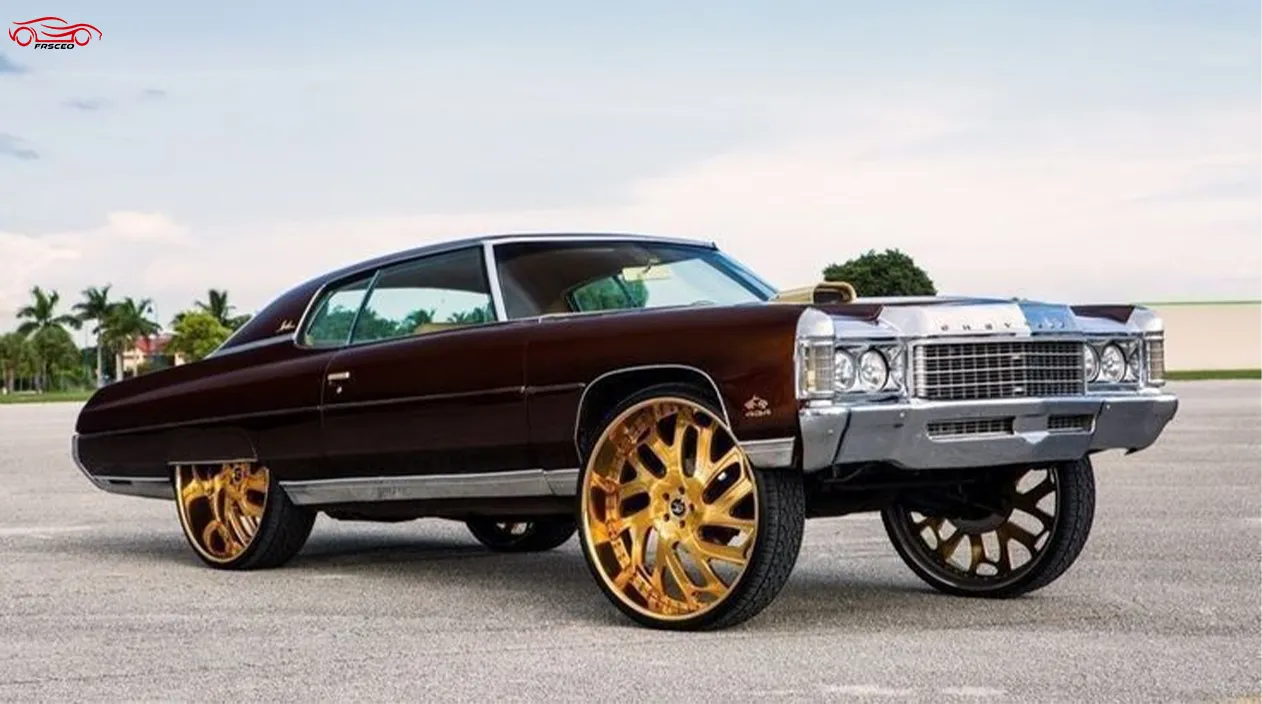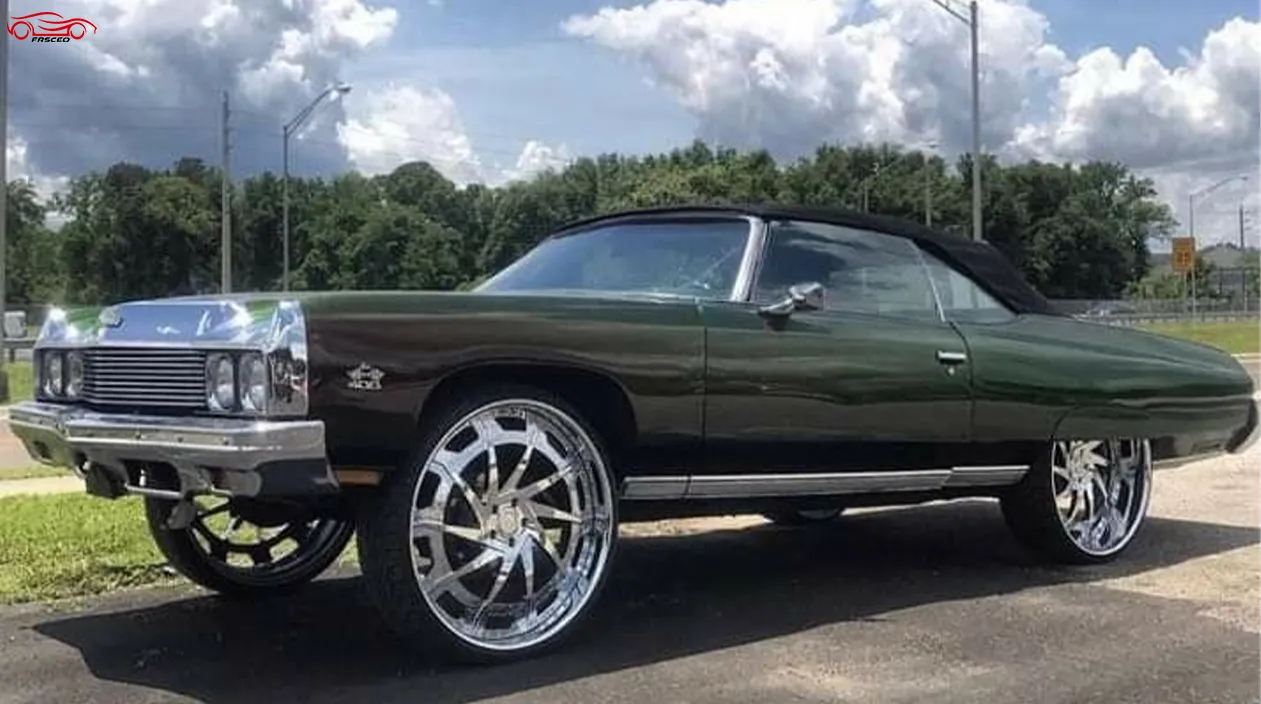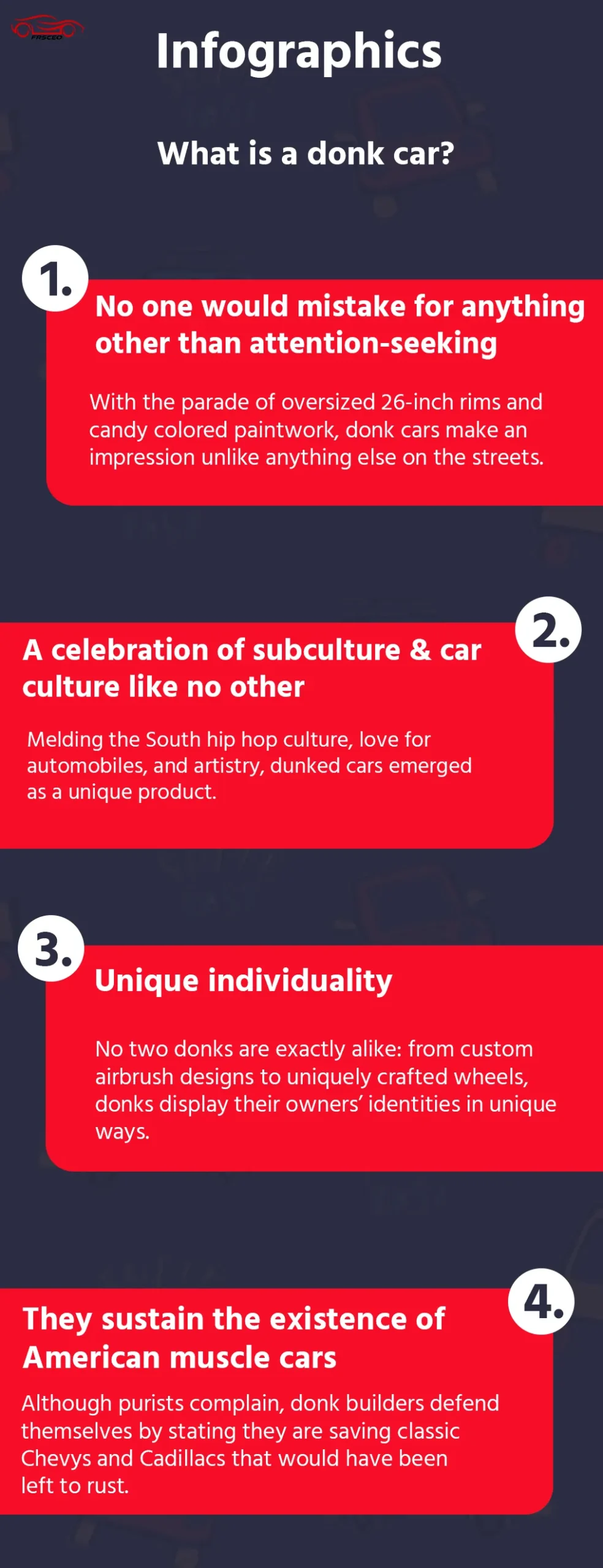Envision this: a 1992 Chevy Caprice sitting taller than some SUVs and sporting 30-inch chrome wheels that glimmer like the sun. That’s no custom shop daydream—that’s classic donk car, arguably, donk cars are one of the most popularized vehicles in America. And you thought the cars were simply altered models. They are, in fact, mobile monuments of mechanical mischief and regional boastfulness.
“Building a donk isn’t about following trends—it’s about being seen from three blocks away.” – Lil Tee, a Tampa donk builder
Here’s what you will find;
- Authentic source of donk cars origin (It’s not what you think)
- Tips on spotting real donks vs fakes
- 2024 do-it-yourself and purchase pricing estimates
- Current active users of donk culture worldwide (Locational chart)
- Best care practices for these extraordinary vehicles
What Is a Donk Car?
Donk cars are a subculture of car modifications that originated during the 90s southern hip hop culture.
Features of a True Donk
- Original Model: Chevrolet’s Caprice and Impala manufactured between 1971 to 1996.
- Body Modification: The vehicle is raised by 6-12 inches and not lowered like lowriders do.
- Rims: A minimum size of 24 inches, but commonly 26-30 inches.
- Color: Airbrushed artwork or candy paints.
- Local Subcultures:
Miami: Donk lovers use bright pastel colors.
Atlanta: Use metallic flake colors.
Houston: Known for “Slab” style, which uses smaller wheels.
Main Point: These do not include boxes (80s-90s sedans) or bubbles (00s Chrysler 300s). In contrast to other slangs, donks are used with B-body Chevys.

Some Donk Building Basics That Are Often Overlooked
Transforming a classic Chevy into a donk car takes more than putting on oversized wheels—it is an art and engineering combined effort. Whether you want a showpiece or street-ready donk, here’s what goes into building one from the ground up.
As quoted by a Miami Donk builder, “Building a donk is like crafting a diamond, start with the right base, cut it right, and polish it until it shines.”
Curious about car buying tips or maintenance advice? Dive into our Blog for expert insights and guides to make informed decisions.

The Foundation (Cost: 3k-10k)
Every great donked car starts with the right donor vehicle, and Chevies don’t grow on trees. Here’s what to look for:
- 1977-90 Chevy Caprice/Impala: Most popular choice due to strong aftermarket support.
- 1991-96 B-body models: Increasingly rare, driving prices up.
- Avoid: Rusted frames, salvage titles, or poorly maintained engines.
Pro Tip: A clean, low-mileage Caprice in good condition can run you $5k-10k before modifications.
The Lift (Cost: 4k-12k)
Lifting a donk car is as simple as cranking up the suspension. Ensuring safety and drivability are hinges of proper execution:
- Traditional Lift: Spring spacers + extended shocks (lower cost).
- Premium Lift: Custom 4-link air suspension (smoother ride, adjustable height).
- Critical Upgrades: Modular brake line sets, upgraded driveshaft.
Why It Matters: A donk that has been poorly lifted may handle dangerously—always consult a professional.
Wheel Setup (Cost: 5k–20k)
The wheels donned on a donk car indeed bring instant race recognition courtesy of its big rims and wheels. Larger doesn’t always mean better, so aesthetics need to be balanced with how well the wheels perform.
- Entry-Level: 26″ Forgiato wheels ($8k/set)
- Show Quality: 30″ Asanti wheels ($20k+).
- Tires: Ultra low profile (25-30 aspect ratio) for the right stance.
Warning: Wheels over 30 inches may require body modifications to avoid rubbing.
Paint & Body (Cost: 10k-50k)
A donk car’s paint job is its signature. From simple candies to full murals, options vary widely:
- Basic: Single-stage candy paint (8k-15k).
- Showstopper: Custom airbrushing (+20k).
- Pro Tip: Florida and Atlanta shops dominate the donk paint game.
Maintenance Note: High-end finishes need constant waxing and prefer living in a garage.
Total Build Range
- Street Donk (25k-50k) – Reliable, daily-drivable but still eye-catching.
- Show Donk (75k-150k) – Award-winning quality, detailed craftsmanship.
- Legendary Builds (200k+) – One of a kind, celebrity-owned donks.
Building a donk car is an investment, both financially and culturally. Choose your build level wisely.
Why Do People Love (or Hate) Donk Cars? The Great Debate
The donk cars phenomenon evokes reactions unlike any other automotive trend. You either admire their audacity or, truly, hate the car culture attached to this vehicle. In this article, we will examine the controversy surrounding donk cars and why they evoke such polarizing sentiments in the car community.
Why Fans Love Donks

No one would mistake them for anything other than attention-seeking
With the parade of oversized 26-inch rims and candy colored paintwork, donk cars make an impression unlike anything else on the streets. For donk car owners, being noticed serves a crucial part of the appeal.
A celebration of subculture and car culture like no other
Melding the South hip hop culture, love for automobiles, and artistry, dunked cars emerged as a unique product. What started out as a street fad in Miami rapidly developed into an automotive movement with proper donk car exhibitions around the country.
In addition to the beauty and audacity, dunk cars capture the art of storytelling through the automobile.
Unique individuality
No two donks are exactly alike: from custom airbrush designs to uniquely crafted wheels, donks display their owners’ identities in unique ways. While some opt for murals, others lean into sleek metallic finishes. The possibilities truly are endless.
They sustain the existence of American muscle cars
Although purists complain, donk builders defend themselves by stating they are saving classic Chevys and Cadillacs that would have been left to rust. The donk car community launches these vintage models with modern touches.
Why Critics Hate Donks
“They show no respect for automotive history.”
Most classic car lovers would cringe at the sight of 1970s Impalas being donked. This school of thought believes these vintage cars should remain in their original form and not be used as canvases for creative expression.
Function takes a backseat to form
The gigantic tires and lofty suspensions wreak havoc on:
- Handling
- Braking
- Fuel economy
For a performance-minded driver, these outrageous donk additions make no logical sense.
They skirt the edges of legality
Some states are very particular about:
- Maximum size for rims (donks are notorious for exceeding these limits)
- Height of the suspension system
- Darkness of window tints
Because of these reasons, some donk car builds become controversial from a legal perspective.
This isn’t everyone’s taste
Beyond the booming bass systems, bright LEDs, and paint job, donks hold true to a very specific style. People who appreciate and prefer understated elegance find donks profoundly distasteful.
“Donks are like pineapple on pizza – you either get it or you don’t. But you can’t deny they make an impression.” – An Automobile Reporter
It doesn’t matter if you are a skeptic or a dedicated follower of a ‘donk car’ enthusiast, one thing is true: these striking constructions still influence the car culture in the United States. Their willingness to elicit such fiery arguments ensures that they are much more than mere automobiles – they are statements of society on wheels.
Popular Donk Cars and Their Cultural References
Donks are visible in songs, programs, and even on social media:
- Music Videos: Donks are used in videos by rappers such as Rick Ross and DJ Khaled.
- Car Shows: People come in huge numbers to Donktoberfest.
- Instagram and YouTube: Donk Life and others have large followings.
Final Verdict: Are Donk Cars Worth It?
Love them or hate them, donk cars are a part of our culture and iconography, which merges elements of automobile customization, music, and Southern aesthetics.
If you want a donk-like ride that catches everyone’s attention, then a donk is the vehicle for you. However, if you prefer classic restoration or performance builds, then a donk is definitely not for you.
Now, you know what donk cars are, so would you drive a donk? Visit frsceo for more information regarding cars.



